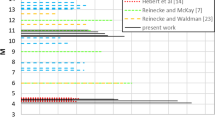Abstract
The effect of incident shock wave strength on the decay of interface introduced perturbations in the refracted shock wave was studied by performing 20 different simulations with varying incident shock wave Mach numbers (M ~ 1.1− 3.5). The analysis showed that the amplitude decay can be represented as a power law model shown in Eq.7, where A is the average amplitude of perturbations (cm), B is the base constant (cm−(E−1), S is the distance travelled by the refracted shockwave (cm), and E is the power constant. The proposed model fits the data well for low incident Mach numbers, while at higher mach numbers the presence of large and irregular late time oscillations of the perturbation amplitude makes it hard for the power law to fit as effectively. When the coefficients from the power law decay model are plotted versus Mach number, a distinct transition region can be seen. This region is likely to result from the transition of the post-shock heavy gas velocity from subsonic to supersonic range in the lab frame. This region separates the data into a high and low Mach number region. Correlations for the power law coefficients to the incident shock Mach number are reported for the high and low Mach number regions. It is shown that perturbations in the refracted shock wave persist even at late times for high incident Mach numbers.
Similar content being viewed by others
References
Richtmyer R.D.: Taylor instability in shock acceleration of compressible fluids. Commun. Pure Appl. Math. 13, 297–319 (1960)
Meshkov E.E.: Instability of the interface of two gases accelerated by a shock wave. Fluid Dyn. 4, 101–104 (1972)
Brouillette M.: The Richtmyer–Meshkov instability. Annu. Rev. Fluid Mech. 34, 445–468 (2002)
Kane J., Drake R.P., Remington B.A.: An evaluation of the Richtmyer–Meshkov instability in supernova remnant formation. Astrophys. J. 511, 335–340 (1999)
Anderson M.H., Puranik B.P., Oakley J.G., Brooks P.W., Bonazza R.: Shock tube investigation of hydrodynamic issues related to inertial confinement fusion. Shock Waves 10, 377–387 (2000)
Zabusky N.J.: Vortex paradigm for accelerated inhomogeneous flows: Visiometrics for the Rayleigh–Taylor and Richtmyer– Meshkov environments. Annu. Rev. Fluid Mech. 31, 495–536 (1999)
Krivets, V.V., Long, C.C., Jacobs, J.W., Greenough, J.A.: Shock tube experiments and numerical simulation of the single mode three-dimensional Richtmyer-Meshkov instability. In: 26th International Symposium on Shock Waves. pp. 1205–1210. Springer, Gottingen (2009)
Motl B., Oakley J., Ranjan D., Weber C., Anderson M., Bonazza R.: Experimental validation of a Richtmyer–Meshkov scaling law over large density ratio and shock strength ranges. Phys. Fluids 21, 126102 (2009)
Chapman P.R., Jacobs J.W.: Experiments on the three-dimensional incompressible Richtmyer–Meshkov instability. Phys. Fluids 18, 074101 (2006)
Ranjan D., Oakley J., Bonazza R.: Shock-bubble interactions. Annu. Rev. Fluid Mech. 43, 117–140 (2011)
Ranjan D., Niederhaus J., Motl B., Anderson M., Oakley J., Bonazza R.: Experimental investigation of primary and secondary features in high-Mach-number shock-bubble interaction. Phys. Rev. Lett. 98, 024502 (2007)
Ranjan D., Anderson M., Oakley J., Bonazza R.: Experimental investigation of a strongly shocked gas bubble. Phys. Rev. Lett. 94, 184507 (2005)
Prestridge K., Vorobieff P., Rightley P.M., Benjamin R.F.: Validation of an instability growth model using particle image velocimetry measurements. Phys. Rev. Lett. 84, 4353–4356 (2000)
Balakumar B.J., Orlicz G.C., Tomkins C.D., Prestridge K.P.: Particle-image velocimetry-planar laser-induced fluorescence measurements of Richtmyer–Meshkov instability growth in a gas curtain with and without reshock. Phys. Fluids 20, 124103 (2008)
Brouillette M., Sturtevant B.: Experiments on the Richtmyer–Meshkov instability: small-scale perturbations on a plane interface. Phys. Fluids A Fluid 5, 916–930 (1993)
Herrmann M., Moin P., Abarzhi S.I.: Nonlinear evolution of the Richtmyer–Meshkov instability. J. Fluid Mech. 612, 311–338 (2008)
Gupta M.R., Roy S., Khan M., Pant H.C., Sarkar S., Srivastava M.K.: Effect of compressibility on the Rayleigh–Taylor and Richtmyer–Meshkov instability induced nonlinear structure at two fluid interface. Phys. Plasmas 16, 032303 (2009)
Rikanati A., Oron D., Sadot O., Shvarts D.: High initial amplitude and high Mach number effects on the evolution of the single-mode Richtmyer-Meshkov instability. Phys. Rev. E 67, 026307 (2003)
Schilling O., Latini M.: High-order WENO simulations of three-dimensional reshocked Richtmyer-Meshkov instability to late times: dynamics, dependence on initial conditions, and comparisons to experimental data. Acta Math. Sci. 30, 595–620 (2010)
Thornber B., Drikakis D., Youngs D.L., Williams R.J.R.: The influence of initial conditions on turbulent mixing due to Richtmyer–Meshkov instability. J. Fluid Mech. 654, 99–139 (2010)
Leinov E., Malamud G., Elbaz Y., Levin L.A., Ben-Dor G., Shvarts D., Sadot O.: Experimental and numerical investigation of the Richtmyer–Meshkov instability under re-shock conditions. J. Fluid Mech. 626, 449–475 (2009)
Schilling, O., Latini, M., Don, W.: Physics of reshock and mixing in single-mode Richtmyer-Meshkov instability. Phys. Rev. E 76(2007)
Niederhaus, J.H.J., Ranjan, D., Oakley, J.G., Anderson, M.H., Greenough, J.A., Bonazza, R.: Computations in 3D for shock-induced distortion of a light spherical gas inhomogeneity. In: Shock waves, Part XVIII. Springer, Berlin, pp 1169–1174. doi:10.1007/978-3-540-85181-3_60
Dimonte G., Ramaprabhu P.: Simulations and model of the nonlinear Richtmyer–Meshkov instability. Phys. Fluids 22, 014104 (2010)
McFarland J., Greenough J., Ranjan D.: Computational parametric study of a Richtmyer–Meshkov instability for an inclined interface. Phys. Rev. E 84, 026303 (2011)
Aleshin A.N., Zaitsev S.G., Lazareva E.V.: Damping of perturbations at a shock front in the presence of a Richtmyer–Meshkov instability. Sov. Tech. Phys. Lett. 17, 493–496 (1991)
Aleshin, A.N., Chebotareve, E.I., Krivets, V.V., Lazareva, E.V., Sergeev, S.V., Titov, S.N., Zaytsev, S.: Investigation of Evolution of Interface After Its Interaction with Shock Waves. International Institute for Applied Physics and High Technology, Moscow (1996)
Kolev T.V., Rieben R.N.: A tensor artificial viscosity using a finite element approach. J. Comput. Phys. 228, 8336–8366 (2009)
Sharp R.W., Barton R.T.: HEMP Advection Model. Lawrence Livermore Laboratory, Livermore (1981)
Author information
Authors and Affiliations
Corresponding author
Additional information
Communicated by R. Bonazza.
Rights and permissions
About this article
Cite this article
Bailie, C., McFarland, J.A., Greenough, J.A. et al. Effect of incident shock wave strength on the decay of Richtmyer–Meshkov instability-introduced perturbations in the refracted shock wave. Shock Waves 22, 511–519 (2012). https://doi.org/10.1007/s00193-012-0382-y
Received:
Revised:
Accepted:
Published:
Issue Date:
DOI: https://doi.org/10.1007/s00193-012-0382-y




